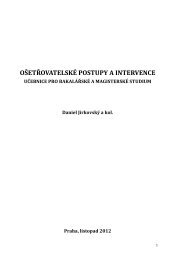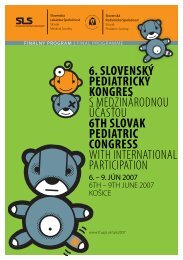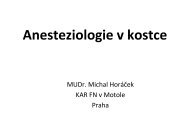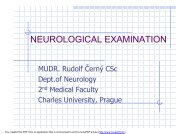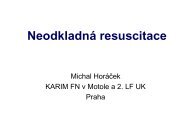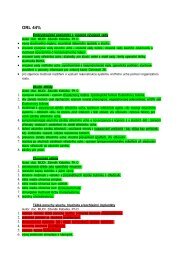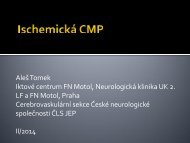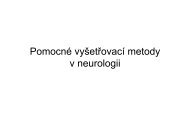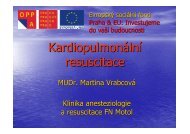Zde - 2. lékařská fakulta - Univerzita Karlova
Zde - 2. lékařská fakulta - Univerzita Karlova
Zde - 2. lékařská fakulta - Univerzita Karlova
You also want an ePaper? Increase the reach of your titles
YUMPU automatically turns print PDFs into web optimized ePapers that Google loves.
P-38. CARDIAC SUBMILISIVERT VOLUME (SCREENING) CT.Profantova N., Belsan T., Charvat F., Krahula O.Department of Radiology, Military University Hospital, PragueSupervisor: Doc. MUDr. Charvat Frantisek, Ph.D.Introduction: Exposure of patients to X-ray doses is rather high during coronary angiography.Aims: The aim of our study is to demonstrate the possibility of radiation dose reduction during theimaging of coronary arteries by adjusting the examination parameters during CT scanning. Dynamicvolume CT scanner was used to obtain images. Main advantages of this CT device and these types ofscanning protocols are dose reduction, small amount of contrast medium, duration of examination,noninvasivness.Materials and Methods: The imaging was carried out on the CT Aquilion One with 320 row detector.21 patients (19 males, 2 females, average age 37,5 years, heart rate 57±3,7 bpm) were examinedusing customized scan protocol. This protocol was based on the patient’s body mass index (BMI)(23,8±1,9). The examination parameters of the protocol (voltage 100 kV, tube current 200-570 mA,scan range 10-16 cm, rotation time 0,35 s) were adjusted for each patient.Results: The goal was to decrease amount of radiation bellow 1 mSv without reduction of imagequality. Based on our results, to meet this goal, the scan range is adjusted to the BMI and tubecurrent. In our study we met our criteria in almost all patients, only one patient had BMI 30 and hisradiation dose had to be increased above 1 mSv.Conclusions: Adjustment of the examination parameters can lead to a significant reduction ofradiation dose. This examination protocol can be used in certain patients, whose BMI is not too high(ideal below 26). In indicated cases, this can be used as standard protocol, which reliably showscoronary arteries.70



